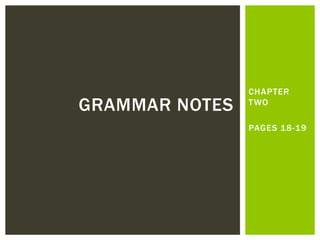
Chapter two grammar notes
- 2. Use the simple past to express an action, event or state occurring at a specific time in the past. 1.
- 3. Examples: Runze wanted to get married. (general) She filled out an application form several days before the wedding. (specific) 1.
- 4. Use the past progressive (past continuous) to express an action that was in progress (not finished) at a time in the past. 2.
- 5. Example: Runze was studying pharmacy at the University when she decided to get married. 2.
- 6. Use the present perfect without “for” or “since” to express an action, state or event occurring at an indefinite time in the past. 3.
- 7. Example: How many Americans have ever considered an arranged marriage? 3.
- 8. BE CAREFUL!! The present perfect does not express past time, finished in the past, if used with a time expression that gives a specific time in the past: 3.
- 9. Incorrect: **Weinlick has gotten married a few years ago. Correct: Weinlick got married a few years go. 3.
- 10. Incorrect: **I have come to the U.S. in 2008. Correct: I came to the U.S. in 2008. 3.
- 11. They have already met. (Present perfect for an indefinite time in the past.) The two met on June 8, 1998. (Simple past for a definite time in the past.) 3.
- 12. Remember that with for or since, the present perfect connects the past and the present: 3.
- 13. For example: I have attended many weddings since then. I have known my best friend for more than fifty years. 3.
- 14. Use used to + base form to show a habitual action, event or state that was true in the past but is no longer true. 4.
- 15. For example: Kayoto used to play tennis a lot (but doesn’t play tennis any more). 4.
- 16. You can also use would + base form to express actions or events that occurred regularly during a period in the past. 4.
- 17. For example: When we were children, we would spend every summer in Maine. 4.
- 18. BE CAREFUL!! Used to and would are similar in meaning when they express repeated past actions. 4.
- 19. For example: When we were children, we would spend every summer in Maine. OR When we were children, we used to spend every summer in Maine. 4.
- 20. But don’t use “would” for a situation or condition that continued for a period in the past: I used to live in Chicago. (location) Incorrect: **I would live in Chicago. 4.
- 21. Mia used to be a nurse. (occupation) Incorrect: **Mia would be a nurse. 4.
- 22. We used to have a summer home. (possession) Incorrect: **We would have a summer home. 4.
- 23. Use the past perfect to show an action, event or state of being that happened before a certain time in the past. 5.
- 24. For example: By June 13, the family had interviewed dozens of candidates. 5.
- 25. Use the past perfect with the simple past to show which of two past actions, events or states happened first. 5.
- 26. For example: Weinlick and Runze had known each other for five days when they got married. 5.
- 27. The past perfect is usually used when we begin a sentence by talking about the later event: 5.
- 28. For example: By the time the wedding day arrived, Weinlick had prepared everything. 5.
- 29. The past perfect is not often used in sentences with before or after. The simple past is generally used to describe both events. 5.
- 30. For example: Weinlick started advertising for a bride after he graduated from college. (= He graduated from college before he started advertising for a bride.) 5.
- 31. Use the past perfect progressive (= past perfect continuous) to express an action that was in progress before another past event, and continued up until that time. 6.
- 32. For example: She had been working (for five years) when she got married. 6.
- 33. Use was/were going to or would + base form for an action that was planned or expected in the past. 7.
- 34. For example: Weinlick knew that he was going to get married on June 13, 1998. He knew where the wedding would be. Note: You can also think of these as examples of indirect speech. 7.
